The author Douglas Adams once wrote in one of his comic science fiction books that in no language in the universe (his universe was full of weird civilisations and even weirder aliens) will you find the expression “as beautiful as an airport”. That’s because they never are. They are necessary structures, like public conveniences, recycling depots and sewage farms: essential but seldom what you’d call pretty. The best their designers, operators and customers can hope for is efficiency and the chance for travellers to get through them and out the other side as quickly and with as little difficulty as possible. I’m sure you’ve been through a few. About the most comfortable and pleasant I can recall from recent years, ironically, is Baku airport in Azerbaijan: clean, spacious and wholesome, with good coffee. The oddest (although this was many years ago) was Lomé Airport in Togo, where flight announcements were made by somebody walking around the sweltering, overcrowded warehouse-like departure lounge (no seats, as I recall) wielding a megaphone. There were no skyways, either, and it’s a long climb up the metal steps to a jumbo-jet. It’s probably been developed since then and is very nice by now. I look forward to finding out one day. Togo, after all, is something of a hidden gem in Africa.
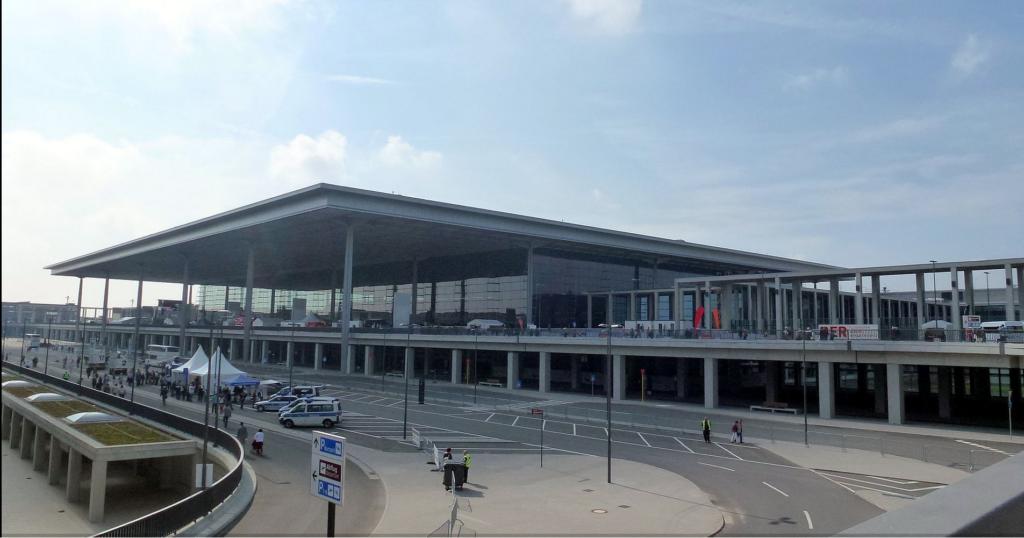
Somehow, you might expect the snazziest, most up-to-date and fully functional airport to be the one serving Germany’s capital city, Berlin. Alas, no. Although it may be someday, perhaps next year? Who knows? Its record of perpetual delays, however, is not promising. At present, plans are afoot to open it for business this October. After all, with its projected annual passenger numbers in the millions, it’s not as if it’s going to be underused. But this airport, named after the former West Berlin mayor and Nobel Prize-winning Chancellor of West Germany, Willy Brandt, has been subject to an amazingly long series of costly delays. When it was announced, back in 2006, its outturn cost rose from the €1-billion, mentioned in 1995 before plans were approved, to an estimated €2.4-billion. It has already exceeded €7-billion and looks set to climb higher (€8-billion is being touted) before the scream of a jet engine disturbs the peace above the tarmac. In fact, at the moment it’s the only thing that is climbing higher. The airport was supposed to open in 2011 and a lavish party was planned for 2012, at which Angela Merkel would cut the ribbon in front of 40,000 invited guests. However, a long list of faults in the construction, some very minor, some quite worrying, has cast some doubt on Germany’s so far justified reputation for engineering excellence. The people of Berlin thought they were getting a BMW 7 series of an airport and so far, have been struggling with a 2-stroke Trabant.

OFF THE RAILS
Of course, cost overruns and unexpected obstacles are par for the course with any large construction project. The United Kingdom, for instance, can look with no pride whatsoever at the High Speed 2 (HS2) rail project that was supposed to link London with the under-represented north of England. The ambition of its initial plan has shrunk just as its estimated cost has soared. It was originally estimated to cost £56-billion (€66-billion) but a government-commissioned review by the former Chairman of HS2, Doug Oakervee, recently suggested the cost would be more likely to reach £106-billion (€125-billion). This must have come as an unwelcome surprise for the current chairman, Allan Cook, who just four months ago set the estimated cost at between £81-billion (€95-billion) and £88-billion (€104-billion). Meanwhile, groups opposed to its construction as a vast, destructive waste of money, like Britain’s Tax Payers’ Alliance, say it’s more likely to cost £150-billion (€177-billion) while other protestors say the cost could be as much as £237-billion (€280-billion).
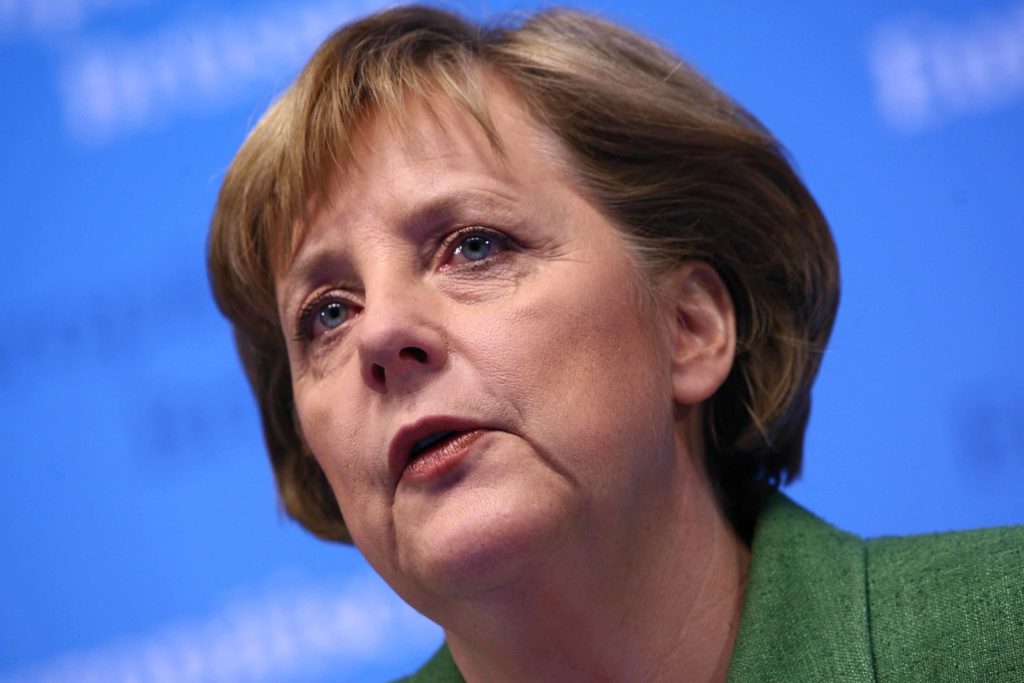
And most (but not all) people – apart from politicians and London-based chief executives- don’t seem to want it. It may never fulfil its initial goals, either: it was supposed to come in three phases, the first from London to Birmingham and with later stages to Manchester and Leeds, cutting journey times by half but missing out, for instance, Nottingham and Derby along the way and leaving out two key city destinations, Newcastle and Liverpool, altogether. It is currently quicker to travel from London to Paris on the Eurostar than it is to take an express train to Liverpool. However, it now seems more likely that Phase One of HS2 stop at Birmingham, anyway, and get no further.

The idea is to start from London’s Euston Station, where work has already begun, link with the new Crossrail line across London and then tunnel its way under the rest of London and cut through rural Buckinghamshire and the Midlands before it gets to Birmingham. Eventually. And nature conservancy groups, such as the Woodland Trust, say the first two phases – if they go ahead – would mean cutting through 104 ancient woods, destroying historic landscapes and killing wildlife. Even if only the first phase goes ahead (as seems likely) it will mean the destruction of 34 ancient woods. Oh, and there are allegations of corruption and embezzlement by some as well as of home-owners and land-owners being swindled over compensation. At least Brandenburg Airport doesn’t have that lot to contend with. Well, not in quite the same way, anyway.

construction expert
at Braunschweig Technical University
© TU Braunschweig
The fact that the Brandenburg Airport is going to cost more than expected hardly counts as news. Every big project ends up costing more and, strangely, some people connected with it seem to benefit financially from the mess. Meanwhile, many Berliners, whilst chafing at delays to a project to make them better connected, are treating the whole project as a bit of a joke. Some have called the airport a ‘white elephant’. It has certainly embarrassed politicians, planners and business leaders. Among the things that have contributed to the delay, a BBC report lists more than 550,000 faults during construction. They will, of course, be put right: the new European Parliament building in Strasbourg was plagued with faults when it opened in 1999, much to the amusement of Euro-sceptics. The first few months saw ‘condemned doors’ that couldn’t be opened and uneven floors that the public (and MEPs) never saw. On one upper level, a section of floor had be cleaned only after everyone had gone because an unnoticed part of the design meant that one room overhung the floor of a corridor to a height of just over a metre. Cleaners had to go along it on their hands and knees, as I witnessed myself. Security people seemed keen for me to leave that area. But everything was put right (more or less) and few can now recall the inconveniences of sharing the older Palais de l’europe building with the Council of Europe.
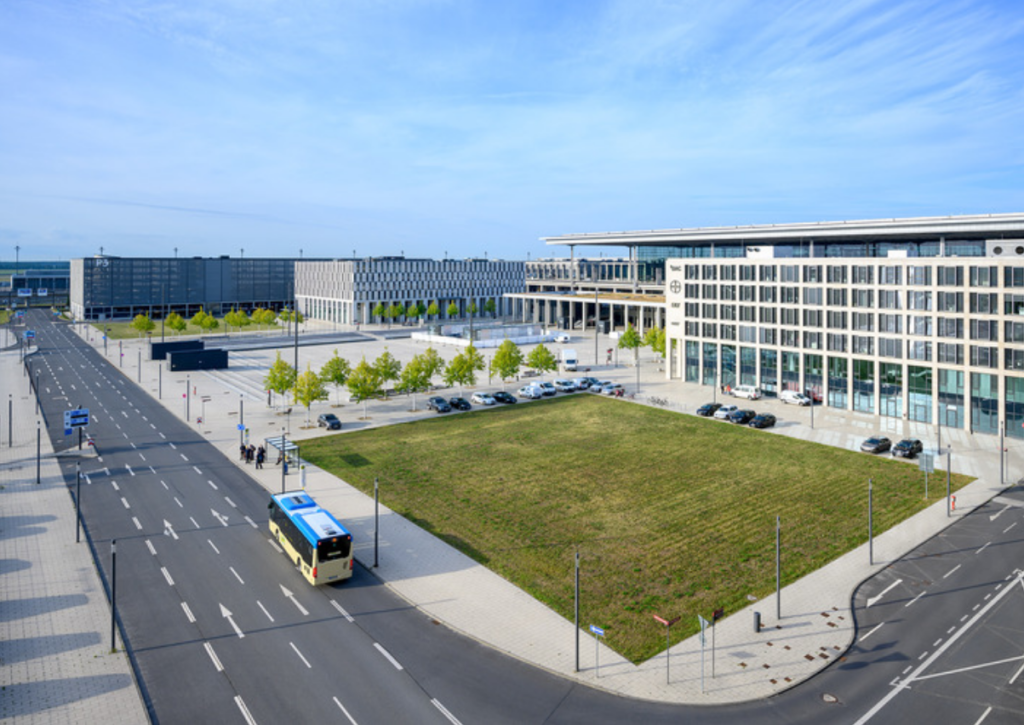
THE AIRPORT AT THE END OF THE WORLD
German media has had fun mocking the planners, politicians and construction companies involved. After all, Germany was famous for punctuality. As one commentator noted, the length of the delay spans Angela Merkel’s entire time as Chancellor (although nobody is blaming her for it). Germany is also famous for bureaucracy, of course, and some are blaming that for the problem, even if the bureaucrats were mainly concerned with meeting safety and environmental standards. “The number of building regulations has quadrupled in the last 20 years,” Engelbert Lütke Daldrup, the fourth manager of the project told Switzerland’s New Zurich Times, “They (the German authorities) only want the best for every area, in fire protection, in impact sound absorption, in energy efficiency, in accessibility, in environmental protections, etc.”
Quoted in TRT World, Professor Patrick Schwerdtner, a construction expert at Braunschweig Technical University, said the culture of bureaucracy amongst officials and the population at large bears much of the responsibility. “Compared to the rest of Europe,” he said, “the German population is inclined to (bureaucratic) conflicts. According to TRT World, he cited the example of the Fehmarnbelt Tunnel, an 18-kilometre-long underwater tunnel linking Denmark’s Lolland island with northern Schleswig-Holstein in Germany. At the current rate, it is not due for completion until 2028. Schwerdtner explained that “on the German side there were 12,600 objections to the project (from members of the public), on the Danish side only a few dozen with mostly constructive proposals.” By comparison, the Brandenburg airport project provoked 133,000 objections during the planning phase alone.
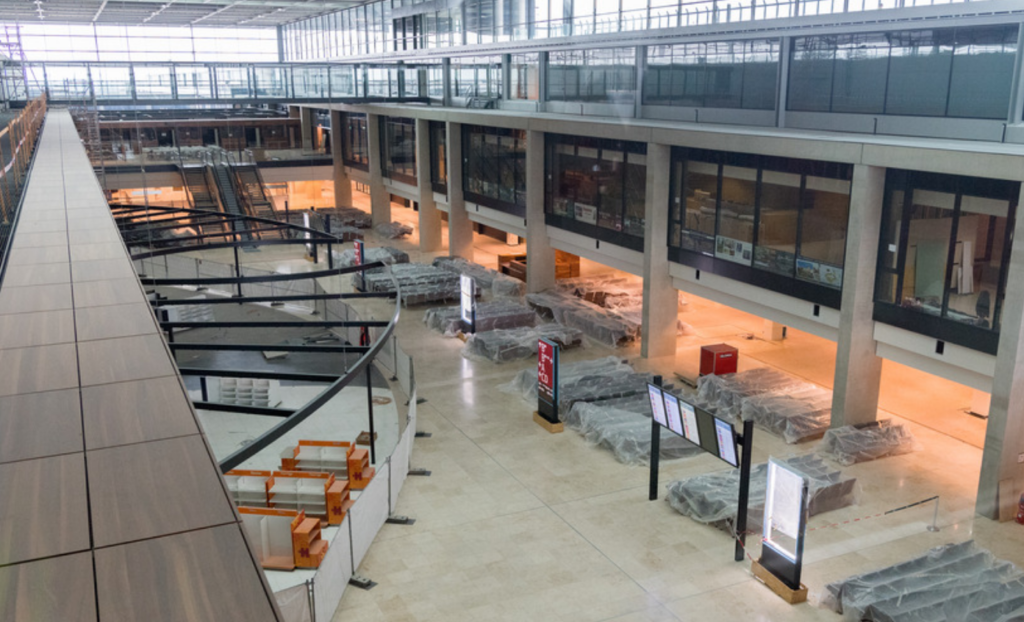
The bureaucracy problems don’t end there, either. Schwerdtner is also critical of management techniques and Germany’s public procurement laws, which state that projects require separate approvals for their planning and execution stages. A project the size of the Willy Brandt-Brandenburg airport has to be divided up into a great number of sub-projects which can only be begun when the preceding project has been satisfactorily completed. By 2009, the airport project was already made up of 45 sub-projects. Schwerdtner says there were mistakes, too, that cost time and money, such as the use of plastic dowels in the construction. Under German building law, dowels must be made of metal, so each and every one had to be located and replaced. There have been accusation of corruption, too. TRT World reports that Jochen Grossmann, whose job it was to oversee the installation of smoke extraction systems, was suspended for taking bribes and later received a one year suspended prison sentence for it. Prosecutors also investigated when a whistle-blower who had reported corruption was allegedly poisoned by somebody who put something put in his coffee, suggesting the involvement of organised crime. He was off work for three months.
The problems with the airport have been dragging on for years. In June 2010 the airport corporation, FBB, announced that the October 2011 deadline – which it described as ‘ambitious’ – would not be met for a variety of reasons, including the bankruptcy of the construction planning company, Planungsgemeinschaft Berlin-Brandenburg International. They postponed the opening date to June 2012. They were, of course, wrong, although the city’s Mayor said at the time that the project was “on schedule”, leading airlines to amend their timetables in expectation of a move to the new site from Tegel and from Schönefeld, the low-cost airport. But in 2015, it was discovered that 600 fire-resistant walls had been installed wrongly and would need to be reinforced or demolished and replaced. Imtech, a Dutch company that had built the fire protection system, filed for bankruptcy. A spokesman for the airport, Daniel Abbou, was sacked after giving an interview to PR magazine in which he wandered off-message, saying there was a “chance” that the airport would open in 2017, unfortunately adding “no politician, no airport director and no person who is not dependent on medication will give you solid guarantees for this airport.” He then spoke a little too truthfully for some: “Earlier, they would mostly say: No, it’s all good. That is bullshit.” His use of an English expression in an interview in German was noted and not favourably.
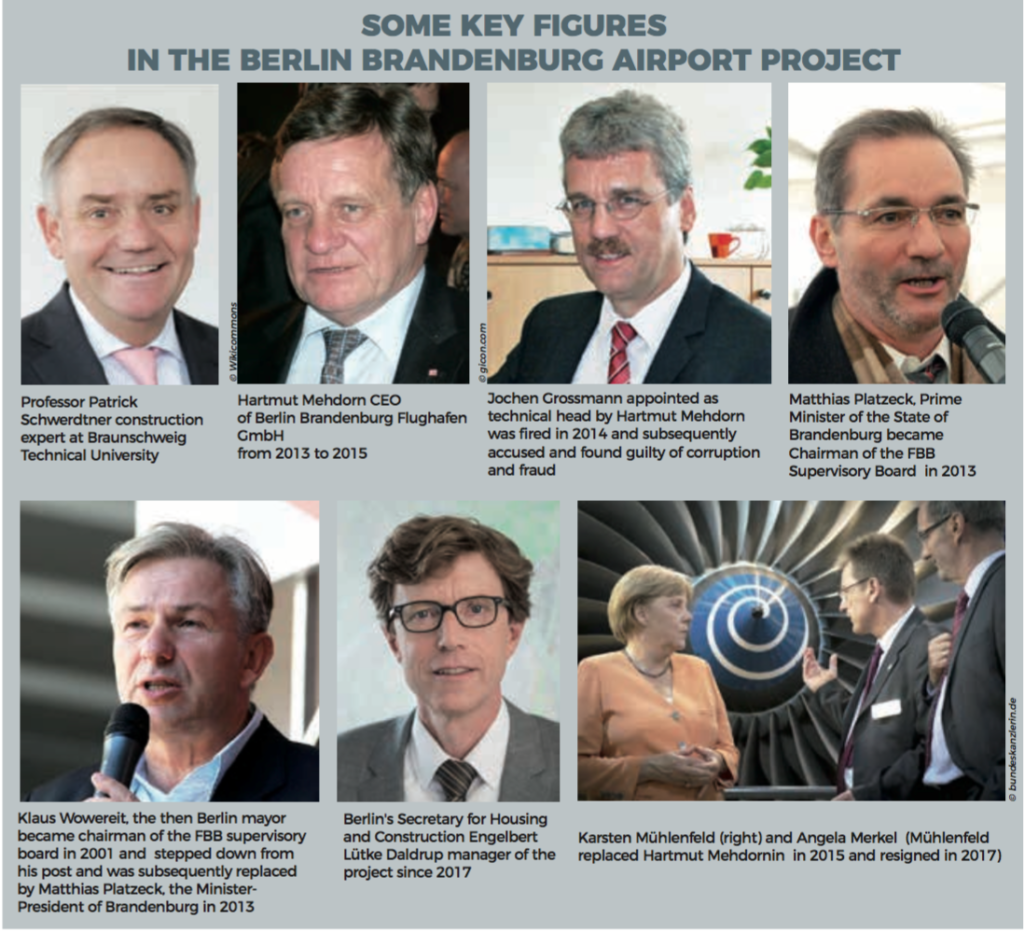
FLIGHTS OF FANCY?
Meanwhile, the whole fiasco is costing German taxpayers some €10-million each month, and they have been getting cross about it. They were demanding that the project should draw to a conclusion. However, in 2017 Daldrup told politicians in Berlin that the sprinkler system still didn’t work and neither did half of the automatic doors. Later that year he suggested that the airport could open in October 2020, although he admitted it might be necessary to use metal shipping containers to house passengers awaiting their flights, at least until work on the new terminal building has been completed. Meanwhile, it was still necessary to maintain the empty building (empty except for various construction workers, that is). It still had to be cleaned and aired while an empty train trundled through the specially-built railway station every day to ensure the tunnels stayed free of mould and the rails remained rust-free. Staff air its empty and guest-free hotel bedrooms and change the sheets. Other parts of the building also had to be kept fit for purpose, however distant that purpose. All of the flight information monitors – 750 of them in all – reached the end of their life expectancy in 2018 and had to be replaced at a cost of €500,000. No passenger had ever looked at one since their original installation.
It was in November last year that Daldrup announced the currently-anticipated opening at the end of this October, although he admits there’s still a lot of work to do. That includes a final safety check by Technischer Überwachungsverein (TÜV), followed by the deployment of some 20,000 volunteers in live tests. Flaughafen Berlin Brandenburg (FBB) advertised at the end of January for people to take part in the tests. Daldrup is still confident the date is feasible and the premier of Brandenburg, Dietmar Woidke, added his vote of confidence by saying that “This time it would happen”.
Those involved must be keeping their fingers crossed: the many delays have already claimed a number of political scalps, such as the airport’s former Chief Executive, Hartmut Mehdorn and the long-serving mayor of Berlin, Klaus Wowereit. There have been some inexplicable slip-ups, too. In 2014, it was revealed that the chief planner for the new airport’s fire protection system, Alfredo di Mauro, was an engineering draughtsman and not – as had been assumed by the organisors – a qualified engineer. He didn’t bother to correct them as to his suitability and qualifications and the mistake ended up costing hundreds of millions of euros to put right.
Anti-corruption bodies are not surprised by what’s been going on. The concluding chapter of The Anticorruption Report Volume 1, Controlling Corruption in Europe stated: “Spending on new infrastructure projects, for example, allows the channelling of government resources to favourite companies either directly or through local or regional governments producing unnecessary outputs with high costs.” According to the European Research Centre for Anti-corruption and State Building (ERCAS), Germany had long been considered a country at ‘low risk’ of corruption. “The FBB signed an Integrity Pact with Transparency Germany in 2005,” says the ERCAS website, “and engaged local public procurement expert Professor Peter Oettel, (Oettel is honorary professor at the Technical University Berlin and was former Head of the Department of Structural Policy for the city where he was responsible for overseeing public procurement) to work with TI in monitoring the awarding of contracts for the airport. According to the FBB, this was the first time a German company took such a step, however, according to Transparency Germany; it took nearly a decade to convince the company to sign the pact.” A bit of a mouthful, that sentence, but it’s how ERCAS reported it. FBB did sign in the end, of course, and took further steps to protect against wrong-doing. “The FBB also has an ombudswoman, an anti-corruption officer and an anti-corruption task force” writes ERCAS. “The FBB reported the suspected corruption to (the) public prosecutor in Neuruppin who then conducted a search of the office of two accused associates as well as the private premises of the chief suspect. The public prosecutor has described the situation as a ‘classic model of corruption in business dealings’.”
While there has been pressure to retain Tegel as a smaller ‘city airport’ to serve business people in a hurry who don’t want to face the long trek out to Brandenburg, some people are already questioning whether the new airport will be sufficiently capacious. There is even talk of starting expansion work as soon as it opens; Germans are inveterate travellers and fly more than any other Europeans: 47.1-million took to the skies last year, a fall of 0.8%, while 244.3-million passengers made international connections in Germany. The slight fall in the number of Germans flying is being put down to concerns about climate change, although trade conflicts and the state of global trade played a part.

It’s not so long since Elon Musk purchased a 300-hectare site at Grüneheide, just to the east of Berlin, for a price of €40.9-million, where he plans to build – eventually – some 500,000 of his Model Y SUVs and Model 3 saloon cars. He is already nervous that his planned factory could face the sorts of delays that have plagued the airport. He also knows how important that airport will be for his factory and its future success. He is not known to be a patient man, but he may not have to be. The opening date has been set and services from the existing Berlin Tegel airport are due to end one week later, on 8 November. The move, according to the Flight Global website will take place in three stages. The new Brandenburg airport’s north runway will become operational on 31 October. The southern runway will open on 4 November. All existing services will transfer there by 8 November, at which point Tegel airport will close to scheduled flights, according to the new airport’s operating company, FBB.
NOT CLEARED FOR TAKEOFF
Willy Brandt Brandenburg was supposed to meet future needs and the expected growth in passenger numbers, as well as providing a hub for the regional airline, Air Berlin. Unfortunately, the project hit another snag when Air Berlin filed for insolvency in 2017, leaving the new airport without a hub airline. This meant that FBB had lost its biggest tenant before the place had even opened. Lufthansa promised to take over some of Air Berlin’s routes but said they would retain their major hubs at Frankfurt and Munich, rather than build a new one at Brandenburg. In the same year, the new airport failed to get safety certification for its underground railway station. Brandenburg was intended also to replace Berlin’s ageing existing airports, Schönefeld, which was the main airport for East Berlin, Tegel, built to handle the Berlin Airlift of 1948-49 at the start of the Cold War, and the famous Tempelhof, which was built in 1927, expanded during the 1930s and used as the main base for the Berlin Airlift. The Tempelhof name originated from the fact that that land on which it stood had once belonged to the Knights Templar. It closed, somewhat controversially, in 2008, and there remains some pressure to retain the airport buildings for historic reasons. Tegel Airport was constructed to handle flights during the Berlin Airlift and is scheduled to close as soon as the new airport is up and running.

The new airport has already grown. It was decided to double its capacity after construction had already begun, which probably accounts for quite a few of its ongoing problems. The team of politicians managing the project had no experience of what they were trying to do so awarded a lot of contracts to small companies instead of a few to large, experienced companies, believing they’d be easier to control and haggle with over price. It didn’t work. Then they discovered something unexpected: the airport’s architect, Meinhard von Gerkan had a peculiar dislike of airport shops that he hadn’t mentioned, commenting that he disliked seeing passengers traipsing around with bags containing alcohol and luxury goods, so failed to provide any space for them. The politicians could see this would be a bad thing and could prevent Berlin developing into a popular hub, so they insisted on an extra floor being built, just to house shops and other facilities. Suddenly, the airport was being changed as it was being built with the result that nobody knew where everything was any more. It had, for instance, been built without any gates for low cost flight operators, only the huge, costly sky-bridges for large jets. The project descended into chaos, although to be honest it had been pretty chaotic from the outset. And underlying the construction were hundreds of kilometres of cabling, much of it tangled and with no-one having any clear knowledge of what connected to which. It had had been so poorly installed that it had to be replaced, another complicated and costly job and it is the cabling and fire safety systems that are most to blame for the delays. Since these were caused by politicians trying to do something at which they lacked experience, blame for the delays could (and perhaps should) be laid at their door. To be honest, the German media and ordinary Berliners don’t know who to blame; they’re just fed up with the whole sorry debacle.
The story isn’t over, either. According to CAPA, the operating company, FBB still needs additional funds of some €300-million, which includes €200-million just to complete work on the main terminal. Oh, and it also needs two hundred extra staff to operate the airport safely. The Chief Finance officer for FBB has said the company is currently setting up a new business plan that takes the finance issue into account. “The previous business plan for the years 2018 to 2037,” writes CAPA, “identified additional funding requirements of €770-million for the period after the opening of BER in Oct-2020, due to loss of revenue from the unfinished main terminal. It took into account the expectation of an increase in revenues based on the increase in passenger numbers from 2021 and improved revenue opportunities in non-aeronautical activities. The board discussed different options for covering financial needs – including even a hire purchase model at the expense of long-term revenue while also committing to raise €400-millions of necessary funds on the capital market.” The saga just goes on and on.
BIGGER AND BETTER
With the UK now having left, Berlin is the European Union’s largest city and most right-thinking people would imagine it would have one of the most efficient airports. Perhaps it will, one day, but it will still face pressure from low-cost carriers and charter flight operators, currently flying out of Schönefeld next door (the existing Schönefeld will become Terminal 5 of the new airport), for lower airport charges. The operators are unhappy because taxi distances to the new airport will be several times as great and they want their charges cut to compensate. FBB would do well to listen carefully to their appeals: low cost and charter flights account for more than 90% of the seats on flights from Schönefeld. Other new airports sited too far from the cities they serve, such as at Kuala Lumpur, have failed and had to be replaced. And the charges at Tegel, currently Berlin’s main airport, are higher than those at Frankfurt, Hamburg and Munich.
But let’s just take a look at some of the strange problems that have afflicted construction at Brandenburg, as cited in an on-line report by the blog, One Mile at a Time: 90,000 metres of cable incorrectly installed; 4,000 doors incorrectly numbered (although that number has been questioned – why would an airport need 4,000 doors?); some escalators were too short (does that mean they stopped before reaching the next floor?); there are not enough check-in desks; FBB had to consider employing hundreds of nightclub bouncers policing the airport 24 hours a day to sound alarms and open doors because the smoke alarm system didn’t work; 3,000 smoke detectors went missing; thousands of lightbulbs shine around the clock because officials can’t work out how to switch them off; hundreds of newly-planted trees had to be cut down because they were the wrong species; the Willy Brandt Foundation is considering revoking the airport’s permission to use his name because the whole project is so embarrassing and could be considered disrespectful to his legacy; flight paths and sound protection zones were incorrectly calculated; the emergency line to the fire department didn’t work; the airport’s roof was twice the permitted height.
COUNTING THE COSTS
It really is hard to imagine how such a prestigious project in such a well-organised city could have descended into something more reminiscent of a sketch from Monty Python. You (and most Berliners) will be relieved at reports in Airports International that testing so far has produced positive results. Daldrup is optimistic that this time the airport really will begin operations in October, even if not quite everything is in full working order. “The results of the operating principle test show that the meticulous work we performed with extensive upstream functional tests has paid off” he said to the magazine. “The fact that the interaction of the fire protection systems works at this level of quality is an essential step on the road to commissioning in October 2020. In particular, I extend our thanks to the staff of the construction and operating section for their commitment. They have achieved a level of success that seemed unattainable to many just a year ago.”
So, what of the specifications, if all goes to plan? Two runways, one of asphalt and 3,600 metres long, the other of concrete and 4,000 metres long, so it can handle the largest aircraft. Projected passenger numbers are around 34-million a year, making it the third busiest airport in Germany and one of the fifteen biggest in Europe. Admittedly, it should have opened years ago but instead it fell victim to poor construction planning, execution, management and corruption. To make way for the new airport, two villages had to be removed. The 335 inhabitants of Diepensee received compensation and were offered new homes in Königs Wusterhausen in 2004, while the 35 villagers of Selchow were resettled in Großziethen the following year.
The mess puts me in mind of a Limerick, one of those short allegedly Irish forms of poetry, often obscene or at least quite rude:
There once was a lady called Jane
Who wanted to ride in a ‘plane
But the airport nearby
Said she still couldn’t fly
So she left it and went on a train.
Will Berlin ever live it down? At least the people wanting to build Britain’s HS2 railway will know they’re not alone in their planning and construction nightmare.
Anthony James
Click here to read the 2020 March edition of Europe Diplomatic Magazine


